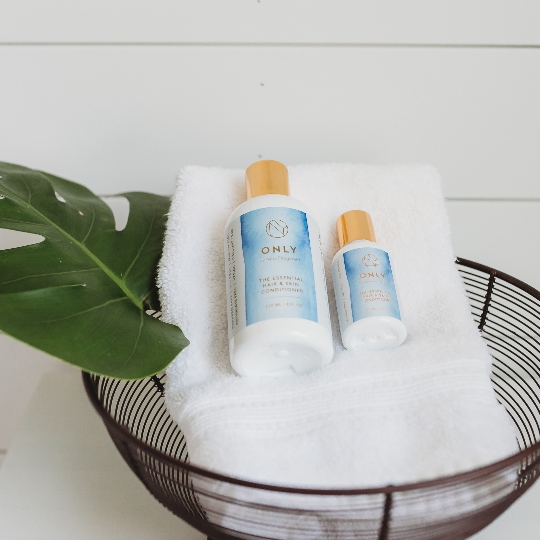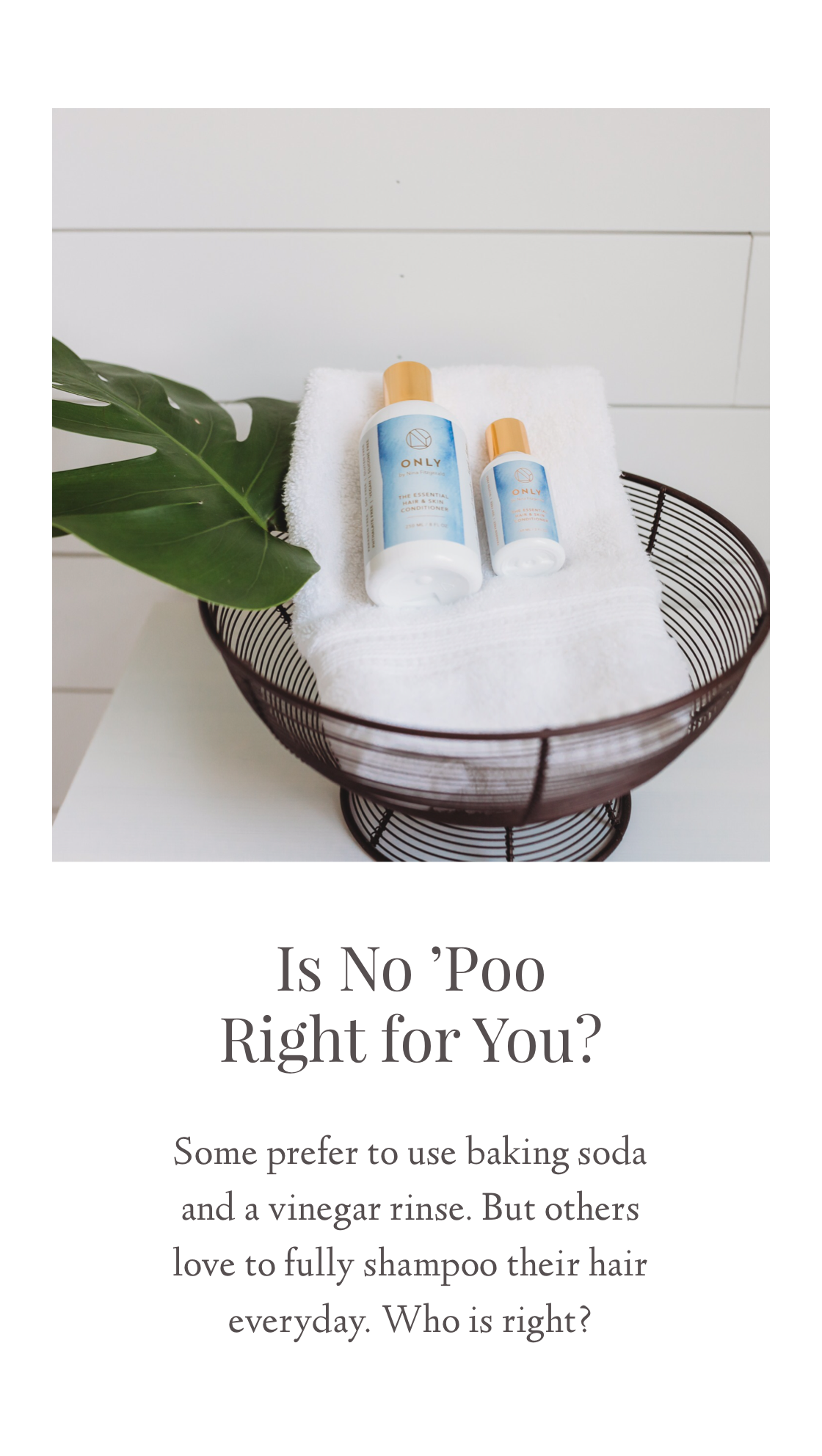New year, new tools for clean beauty
Now that we’ve all had time to get used to this new decade, it’s time to talk about a couple of new stars in the ONLY family that were designed to work perfectly with our line of products: our hairbrush and scalp scrubber!
Hey there, 2020! Nice to meet you. Take your shoes off, get comfortable!
Now that we’ve all had time to get used to this new decade, it’s time to talk about a couple of new stars in the ONLY family that were designed to work perfectly with our line of products: our hairbrush and scalp scrubber!
The scalp scrubber is a pure delight, with wet or dry hair. It’s the perfect accessory for a great co-wash, deep conditioning treatment or your regular shampoo routine. Outside of the shower, use this beauty with a dollop of ONLY to maximize your hair’s volume before you take on the world. (Better yet, take it to go, and give yourself the gift of a quick scalp massage anywhere!)
Our wooden paddle brush fits perfectly in your hand, with enough weight to tackle the most unruly hair — but light enough that you don’t regret giving up that resolution to hit the gym more often. Whether your goal is to detangle, smooth out or just brush-and-go, this is the tool for you.
It’s a new year, with new tools to make you look — and more importantly feel — your best. We’ve got you covered.
Make Your Scalp Happy (And Healthy!)
ONLY’s new silicone scalp and conditioner brush is your new best friend. Its uses include:
Stimulating new hair growth with its soft, flexible bristles.
Exfoliating to reduce dandruff and dry scalp. Just use a dollop of ONLY and scrub it in wet hair, paying particular attention to the crown of your head.
Volumizing dry hair when paired with ONLY Everything.
Our one-piece brush is easy to use, easy to clean and best of all? It feels great!
Stop by Urban Betty to pick yours up today!
Nina’s routine: Where haircare meets science
This process can be used for ANY type of hair, even on pets to help combat dry, itchy skin. And is sensitive enough for the most gentle skin.
I’ve gotten a lot of questions lately about my haircare routine, so now is a good time to come clean. (Come for the beauty advice, stay for the fun dad jokes!)
But seriously, here’s the low down: I haven’t used shampoo on my hair since April. It’s now mid-August and it’s still light and fluffy and not weighed down or oily. Do you know why?
Science.
Believe me, I was the most skeptical of this routine before I started it, and I told myself I would keep doing this routine until my head got really dirty or oily. And then the months started ticking by.
I also told myself that I love the foam in a shampoo, and while I still love bubbles, I love the purple color staying in my hair so much more.
You see, shampoos nowadays have strong enough surfactants to make sure that our hair gets pretty clean without having to heavy-duty scrub. Think about it this way: the surfactant, in the case of shampoo, is the part that helps to break down dirt and oil. It’s the actual cleansing part. The stronger the surfactant, the more dirt and oil will be pulled off -- along with any color, treatments or masks that you’ve recently done.
You can’t use Dr. Bronner’s soap on a duck that has been in an oil spill. You need a strong surfactant like Dawn to break up the oil and grease.
The reverse is also true: You don’t want to wash your hair with Dawn, or any other dish soap for that matter, because it will strip every essential oil off of your head and hair. Hellllooooo, tangle city!
How I wash my hair
1. Soak your hair with water.
2. Take a good quarter dollar’s worth of ONLY and SCRUB it into your scalp. All over. Chances are that you missed the middle back part of your head, so use a little bit more and scrub that spot again.
3. Put your head back under the water for TWO seconds, just enough to re-wet the head and scrub, scrub, scrub again. This time, you’ll start to notice slip. It’ll foam up some, and your hair will start to feel super soft. Put some more ONLY on your hands and immerse from roots to ends. (You may choose to let it sit like this for a bit. The longer it has, the better.)
4. Rinse hair, and then you’re done!
5. For those EXTRA dirty wash days, repeat steps 2 and 3.
PRO TIP
I hear this a lot: “Nina, how are you saving on products when it seems like I’m adding so much ONLY to my hair just to cleanse it?”
Glad that you asked.
Just bring an empty 2 oz. ONLY bottle into the shower. Fill it half with water, and a quarter of the way with ONLY, then shake it really well. Pour this mixed product over your head, making sure that you got every inch of your scalp, while decreasing the amount of product you use.
(But always use the newly mixed product the same day. Discard the rest.)
What I’ve Learned
If you add a product that doesn’t add oil to the hair -- like ONLY -- it’s balanced and doesn’t get oily.
If you have a lot of buildup, scrub ONLY at the roots when hair is dry, wet it just a little bit and scrub it into the scalp to let it suds up. Putting it on dry will concentrate the formula and concentrate the ingredients, since added water will dilute it.
You probably aren’t using enough ONLY if your hair feels dry, and that is from a buildup of your other products.
If your scalp still gets oily, you didn’t scrub it in well enough at the roots when you washed.
This process can be used for ANY type of hair, even on pets to help combat dry, itchy skin. And is sensitive enough for the most gentle skin.
XOXO,
Nina
Is your hair dry, damaged or completely done?
There are visible signs when our hair is on the down and out. But what about the times that it feels dry, but you can’t see any true visible signs of breakage?
You know we’ve all been there: We set an appointment at the salon because those ends, they’re feeling ROUGH. Not only that, we’re dreading that appointment because the stylist is going to tell us, “Yeah, you need to take at least 18 inches off to make this right.” Then you gasp because you don’t even have 18 inches, and oh my gosh does this mean a shaved head??
Then whoosh you wake up in a cold sweat.
Don’t worry, it’s all very normal. We’ve all had to take off some inches because we’ve been a little too chummy with the iron (flat or curling) and our ends have gotten just a little bit toasty.
OR we’ve used the dryer at the gym that got wildly too hot when we were used to a professional dryer, and fried our hair, and had to pin it back … anyone?? OK, maybe that was just me.
OR that time when we added bleach over the ends of the hair just a tad too many times, and for a week it felt like spaghetti when it was wet. OK, OK, that was also me.
What’s your damage?
Those are visible times that our hair was on the down and out. But what about the times that it feels dry, but you can’t see any true visible signs of breakage? When I say visible, I mean that you can see little white nodes or little knots on the side or end of the hair -- as illustrated below -- or you see a strand split into what feels like 17 other hairs.
Non-visible damage is when you run your hand down your hair and it starts to make a creeeeeaaak sound like straw, but you don’t necessarily see any damage. Your ends aren’t making the crinkle double-y right angle -- but it feels like the savannah.
And for those with hair that looks shiny from roots to ends, with no cuticle roughness, or it just looks dull, you are in luck! You may not have to cut off as much as you thought!
Our suspect: Oily build-up
Most often if you can feel dryness or a creak (like you’re stepping on an old floor board), it’s due to an oil build-up -- likely from a product you have been using. If your products contain too many oils, and you don’t wash them off properly, they will cling to the ends of the hair where it is the most porous. Then, once the water has evaporated from the ends of the hair after air- or blow-drying, the oil coats the ends, thus preventing any other water from entering the follicle.
Remember, oil and water don’t mix, so just like a plant that is starved of water in a pot (RIP every plant I tried to grow on my balcony from 2009-2012), the stems will wither and break.
The ends of the hair strand are already weaker than the hair at the base, where it is newly keratinized, and so any excess buildup at the end will make it break faster. When dried out hair breaks, it starts to split, and then those splits will tangle, and then before you know it, your hair has formed an impromptu game of Twister on your scalp.
(Side note, RIP the hair closest to the nape during coat and scarf season. I would love to just classify that as “Fall or Winter,” but living in Texas gives me no expectation of when those seasons actually exist. Sometimes it’s in October, sometimes it never happens -- save for that random day in February when we all pull out the bucket of coats in glee that we can finally wear long sleeves, only to get the heat back by mid-day. I know my native Texans are all nodding in agreement right now.)
Is it time for the big chop?
So back to the story: How do you know if you really need to make that appointment for the big chop? Feel your hair. Does it feel like someone crimped it with a micro crimper meant for a mouse? (If micro-crimpers weren’t big in your day, don’t worry: We’re on a 30-year fashion cycle, so it’s coming back around again.)
Or does your hair feel like a very worn, long wool rug? That hair definitely needs a trim. Like now.
Maybe you feel like you can hold off two more months -- after all, if it’s truly damaged it will break on its own before then, right? Think again. That’s when you need a trim, or you’re going to end up with hair resembling the feather or the tree picture from above.
And if you can’t feel any mechanical damage, and your hair hair feels waxy when it’s wet, with heavy ends? Chances are you just need a simple cleansing to rid yourself of those oily ends.
Wash that build-up right out of your hair
Method One, with Shampoo
Step 1: Find a gentle clarifying shampoo. While I’m working on my own formulation, my ultimate favorite and go to brand is N4. My hair has never felt more clean and refreshed, and since I’m sensitive to everything under the sun, it was nice that this brand never broke me out. If you can’t find it, then just use any gentle shampoo that you have.
Step 2: Shampoo twice, making sure to scrub your scalp and the ends of the hair thoroughly both times.
Step 3: Rinse really really well, and make sure that you can’t feel build-up on the ends of your hair.
Step 4: Take a good handful of ONLY Conditioner and scrub it really well into your scalp. Apply enough so that your whole scalp feels slippery. Then let sit for 1 minute.
Step 5: Rinse.
Step 6: Blow-dry at least one small piece to make sure all old residue has been cleansed.
Method Two, Without Shampoo
This version uses salicylic acid (a component of aspirin) so please do not use if you have a known sensitivity. Salicylic acid is a wonderful exfoliant, and helps rid the scalp of excess dirt and oil.
Step 1: Get a bottle of ONLY Conditioner and a packet of BC powder (aspirin). If you’re going to try this method without the BC powder, you can skip to Step 3.
Step 2: Before wetting your hair, take mix the BC powder into a good palmful of ONLY Conditioner. You can also mix it in a little plastic bowl and bring it to the shower.
Step 3: Put the mixture (or plain ONLY conditioner) on dry hair, scrubbing really well into the scalp and through the ends of your hair. When I mean scrub, pretend you’re trying to get all of the sand out of your scalp after you’ve been on the beach all day.
Step 4: Wet your hair just a little at the scalp, and re-scrub the ONLY until it lathers from roots to ends.
Step 5: Rinse well.
Step 6: Take a new handful of just ONLY Conditioner (nothing added) and repeat the scrubbing process, roots to ends. Then rinse well again.
Step 7: Dry a little piece of hair. Do you feel the same creak, or does it feel healthy and refreshed?
If your hair is refreshed and happy and shiny, yay it’s OK! You don’t have to chop it -- unless you need to even it out. If you’re hair’s not so happy, it might be time to take a little off of the ends.
Give this method a try for a happy scalp and refreshed ends -- and let me know about your results!
XOXO,
Nina
To shampoo or not to shampoo?
Do we really need to shampoo? Believers in the no-poo movement, who prefer to use baking soda and a vinegar rinse, don’t believe so. But, some people also love to fully shampoo their hair everyday. Who is right?
Shampooing has been around for ages: 300 years to be exact. It was originally called “champu” and came from an Indian tradition of massaging the head with fragrant oils. But the modern-day foamy luxurious washes that you know now were only developed around the 1930s, gaining full momentum and popularity by the 1970s and 80s.
But do we really need to shampoo? Believers in the no ’poo movement, who prefer to use baking soda and a vinegar rinse, don’t believe so. But, some people also love to fully shampoo their hair everyday. Who is right?
Well it all comes down to:
cleanliness and how well you scrub,
suds or no suds,
and how well you make sure the hair is balanced back down.
Let’s break this down further. Growing right next to each and every strand of hair is a little gland that produces oil, or sebum, to help the follicle maintain its strength and keep its elasticity.
Aside from natural hair sebum, oil does not have the ability to collapse the cuticle to make it lay flat. All it can do is coat the hair and lead to buildup or breakage if used too often or before the hair is properly hydrated. Yes, it will make it shiny, but add too much and your hair can feel weighed down, flaky and frizzy. This goes for ANY hair type.
That’s why using an oil-free conditioner will balance the scalp and create the perfect environment for hair growth and clear skin.
When properly balanced, it produces enough to cover each individual strand and the scalp remains clear and without excess oil. But, if the scalp is not cleansed properly, over time the excess oil produced on the scalp can lead to dandruff and hair fall. (WHAT!?)
Don’t worry, keep reading.
How pH Levels Affect Your Hair
Think of pH as a level system that exists from 1-14. Right in the middle is neutral water at a 7. Your hair and scalp want to live around the 4.5-5.5 level. Now, the more that your hair stays in the level of 4.5-5.5, the better it will grow, the healthier it will be, and the less oily it will be. Are you following me so far?
Anything that is from 6 all the way to 14 will start to open the cuticle of the hair (think of a pinecone opening) which can lead to water loss. Levels 9 to 14 can actually start to cause damage to the cuticle and really dry out the hair if not properly balanced back.
The suds that are in shampoos, or the surfactants, help to rid the scalp of all of the excess oil, dead skin cells, dirt and grime that has accumulated since the last time that it was rinsed. For the most part, shampoos exist from about 6-8.5. Shampoos lower on the scale are softer, and only open the cuticle a little. Shampoos that are higher on the scale are stronger, opening the cuticle more.
The Low Down on No ’Poo
In the no ’poo world, baking soda does the same job as shampoo. (Baking soda is medium on the pH scale at a 9, the same as a purifying shampoo. They open the cuticle up so it can get rid of the oil and debris.)
The no ’poo method works by using baking soda as a “shampoo” to cleanse and then apple cider vinegar to rinse and neutralize. It can feel like it works, but remember: Baking soda is a very harsh surfactant at a pH of 9. Harsh surfactants can be harmful to your hair and actually lead to more hair distress over time, with more breakage or build up.
Strong cleansing shampoos can also lead to more damage because they can strip all of the natural oils off of the scalp, leading to consistent dryness and flakiness if not properly balanced. And that means potential hair loss!
What works best are very mild shampoos to cleanse normal, everyday dirt and excess oil off of your scalp without fully stripping all of the natural oils that balance your hair.
Do you want to know how you can use ONLY Conditioner like a shampoo? I’ll guide you through co-washing, step-by-step.













